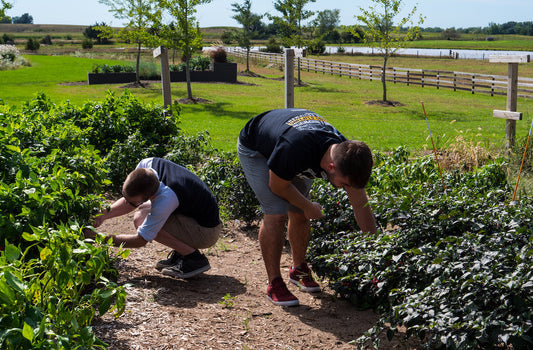
Staking pepper plants is a great step to take in your garden to ensure your plants can stand up to heavy wind and rain. It's common for some pepper varieties to become top-heavy and lanky as they grow taller. To prevent your plants from leaning as they grow, we recommend staking your plants weather they are growing directly in the ground or in containers. Continue reading to learn our favorite ways to stake pepper plants for the best results.
Why Staking Pepper Plants is Important
Staking is where you provide support for your plants with an upright object. Stakes are commonly pieces of wood, plastic, or metal. We recommend you add a stake next to your pepper plants in the early days of their growth journey. This will allow your seedlings to have support as their root systems develop.
If you have a top-heavy plant, the hardening-off process can be more challenging. Intense wind may cause your plant's stem to bend and possibly snap. This can be avoidable with staking. Staking also allows for improved airflow and easier harvesting!

In a single growing season, some plants may grow from 2 to 8 feet tall so staking is more beneficial for some varieties than others. For example, the Capsicum Annum species commonly grows more bushy and lower to the ground. Due to this, the main stem may provide enough support for the whole plant.
Bell peppers are another story. The pepper pods are so heavy they commonly weigh down the plant causing it to break or fall over. For a large pepper variety, you would always want to provide a sturdy support system.
The Capsicum Chinense peppers like Carolina Reapers, Ghost peppers, and Habanero peppers, grow to be much larger and bushier. These also produce many peppers that can weigh the plant down. These plants greatly benefit from a sturdy stake or cage that can be tethered to the plant.
Types of Stakes for Pepper Plants
Wood Skewers
When your seedling is small, a great option for a stake is wood skewers. These provide the minimal support that is needed at this stage. These are perfect for sliding into the soil without damaging the fragile roots. They are typically no more than a half-centimeter wide and pointed at the end.
Traditional Stakes
Traditional stakes are very common. They are straight pointed pieces of wood, bamboo, or metal. You will likely find these at your local garden center. These types of stakes should be driven into the ground 2-3″ from the base of your pepper plants. As your plants grow, you can attach them to different areas of your plant.
Metal Stakes
When it comes to larger pepper plants, metal stakes are excellent. They are commonly plastic-coated and come in a variety of sizes and thicknesses from 2 to 8 feet. A suitable size for most varieties is 3-4 feet.
Tomato Cages
Believe it or not, tomato cages are a fantastic option for supporting pepper plants, especially bushy varieties or types that produce heavy fruits. The circular supports surrounding the cage prop up the hanging branches. Capsicum chinense pepper varieties are typically branch heavy so they would definitely benefit from this staking option. Tomato cages are often around 4 feet in height above the surface of the soil. This option is not practical for small pepper varieties. A standard stake will get the job done.
How to Stake Peppers
Staking pepper plants is a pretty simple process. The main thing to be aware of is not damaging the roots during insertion into the soil.
- Step 1: Identify what direction your plant is leaning. If it is leaning one way, you will want to insert the stake on the opposite side of the plant's base so it corrects the plant's position.
- Step 2: Insert your stake at the base of your pepper plant, about 2-3 inches from the base of the stem. Push it down at least 6 inches or until the stake is sturdy. If you are growing peppers in pots, push the stake to the bottom of the container. Just make sure your stake is long enough. Ideally, you will add the stake to the soil before your plants have been transplanted to avoid penetrating the roots.
- Step 3: Use twist ties, zip ties, or velcro to loosely tether the main stem of the plant to the stake about halfway up the plant. Secure the plant just above the node on the main stem. This will keep the tie from moving as the plant grows.
Additional Growing Tips from Pepper Joe's
We know gardening can be tricky at times. At Pepper Joe's, we work to provide you with as much helpful content that helps you grow the most optimal hot peppers. Browse through our Grow With Joe video series for more information, and be sure to check out our Gardening Tips & Guides that help break down many different pepper growing topics.
Our team of growing experts are here to help you answer any questions you have on growing hot peppers. Feel free to reach out via email or call us at (888) 660-2276 today.







